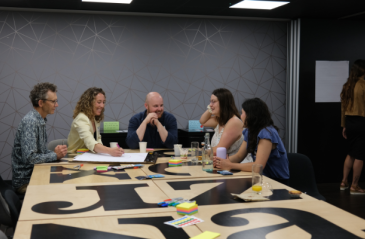
The information barriers holding back climate action and how to break them

When we don’t understand something immediately, we use intuitive judgments
Share articleBy using a scientific mindset effective altruism aims to do the most good
Share articleIt’s surprising how often we don't measure impact...
Share articleWe put our vision for government into practice through learning partner projects that align with our values and help reimagine government so that it works for everyone.
Buzz phrases like ‘evidence-based policy' or ‘doing what works' show that we are more concerned than ever with tracking the outcomes of our actions, not just the effort we expend. But if we're not fully aware of our natural human biases, we're liable to fall victim to a range of fallacies. This is as true of charity and humanitarian aid as it is of policymaking.
Complex issues - whether deciding on the best way to fight preventable diseases, figuring out the optimal macroeconomic policy settings, or predicting how states will react in trade negotiations - are often approached not with the best available evidence but (to borrow a phrase from Bruce Bueno de Mesquita) with “seat of the pants wisdom”. That is, when we don't understand something immediately, we fall back on intuitive gut judgments and prefigured narratives. In our heads we are apt to replace complex questions that are hard to answer with simpler ones, without even realising we're doing it.
Effective altruism is emerging as a strong voice in various fields concerned with ‘doing good' - from charitable giving to career selection. Using a scientific mindset and looking for ways to create the biggest marginal impact, effective altruism aims to answer the question, “how can we do the most good?” It looks at the most important issues facing the world and tries to prioritise the best possible solutions (taking into account our limited resources and the actions of other people).
Why is this important? There's just a lot of ambiguity as to whether social programmes actually work. For example, the Coalition for Evidence-Based Policy (now part of the Arnold Foundation) estimates that, of the US social programmes that it has evaluated, 75% had no impact above the baseline. Work by organisations such as MIT's Poverty Action Lab shows that most interventions have little effect, but that the best have an effect that's many times the average.
What this suggests is that even programmes which seem, at first glance, as though they would be obviously beneficial can turn out to be a waste of time and money when subjected to closer scrutiny. Effective altruism has created a set of thinking tools that give us more clarity when we're trying to decide between competing options under conditions of uncertainty. While these tools were developed with a view to assessing the relative merits of causes (for example, whether it's better to donate to a charity that builds new schools or one that distributes insecticide-treated mosquito nets), they're also useful when thinking about how to prioritise in other domains, including public policy.
Firstly, remember that everything has an opportunity cost. We only have limited resources (time, money, energy, political capital), so whenever we spend these resources doing one thing, we're not spending them on something else. Secondly, measure the good you do. There's no point only tracking inputs if what you care about is outcomes. For example, if you're running a programme trying to improve school attendance, you need to actually measure school attendance and not just enrolments. Thirdly, consider counterfactuals. It's not enough just to measure the outcome that happened as a result of your actions. Would things have turned out better if you hadn't done anything? Or could you have done something differently that would have led to a better result?
Fourthly, think on the margin. Rather than thinking in the abstract about what's the best thing to do, we should think about it in concrete terms - what can we actually achieve? This means taking into account the current context, our abilities and the actions of other people. There's no point investing in a fantastic new public health initiative if another organisation (or government department) is already doing something very similar and you'd be duplicating the effort.
And finally, focus on the best. The world is rarely distributed along a neat bell curve. Many phenomena follow a ‘fat-tailed' or ‘power-law' distribution. That means that some interventions or policies are going to outperform the average by many, many times (possibly several orders of magnitude).
We also use the ITN Framework when comparing causes - Importance, Tractability, ‘Neglectedness'. That is, how bad is a problem, how easily can we solve the problem, and how many people are already trying to solve the problem? A cause or problem that scores highly on all three criteria is a better candidate to be addressed than something that doesn't.
Some of these ideas sound obvious when written down. However, it's surprising how often we fail to do simple things - like measuring the impact of a programme against a control group to prove that it actually caused the impact. A cynic might say that there's a strong incentive to have fuzzy measurements because it makes it easier for people to claim credit for making a difference, whether they did or not. Perhaps a more charitable interpretation is that thinking like this goes against our natural inclinations and requires significant effort to do it well. Given what's at stake, however, I think it's imperative that we do our best to make that effort.
The point is not that these tools are silver bullets for arriving at the unvarnished truth. Instead, they are heuristics that we expect to give us a clearer idea than we would otherwise have had. The most important, overriding virtue that anyone trying to have a scientific mindset should have is ‘epistemic humility'. That is, the knowledge that one is probably wrong - at least about some things - combined with the willingness to take active steps to challenge one's set views and to update one's beliefs as new information comes in, rather than doubling down on a fixed position at all costs.
For more information about elements of effective altruist methodology, you can read Giving What We Can's methodology page, or Doing Good Better by William MacAskill.











